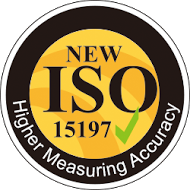ISO 15197:2013



ISO 15197:2013 specifies requirements for in vitro glucose monitoring systems that measure glucose concentrations in capillary blood samples, for specific design verification procedures and for the validation of performance by the intended users. These systems are intended for self-measurement by lay persons for management of diabetes mellitus.
ISO 15197:2013 is applicable to manufacturers of such systems and those other organizations (e.g. regulatory authorities and conformity assessment bodies) having the responsibility for assessing the performance of these systems.
The ISO guidelines for blood glucose meters are a detailed set of standards which blood glucose metersshould meet.
The name ISO stands for International Organization for Standardization, the organisation, based in Geneva, Switzerland, that is responsible for defining the standards.
Currently, the set of standards which need to be met are the set of standards that were published in 2003 (ISO: 15197:2003). In 2013, an updated set of standards (ISO: 15197:2013) were published and these newer standards will need to be met blood glucose meter manufacturers by the end of May 2016.
The ISO standards have a number of different components which need to be met. The 2003 ISO standards included system accuracy and user performance components.
The new 2013 ISO standards included additional components such as:
The system accuracy requirements are carried out by comparing blood glucose results of meters against the glucose level provided by a laboratory measurement. The YSI 2300 STAT Plus glucose analyser is able to perform the laboratory measurement.
The user performance evaluates the accuracy when the testing is performed by patients.
The evaluation of instructions for use is designed to evaluate whether the instructions for the meter are clear enough.
The influence quantities of interferents tests whether the meter can perform effectively for testing blood that has different levels of substances that could interfere with the result of the test. 24 potential interferents are listed by the ISO 2013 standards and these substances include haematocrit levels (the volume of red blood cells in the blood), cholesterol levels and levels of common drugs such as ibuprofen.
Currently blood glucose meters need to meet the system accuracy standards of 2003 (ISO: 15197:2003) which state that 95% of blood glucose results should be: